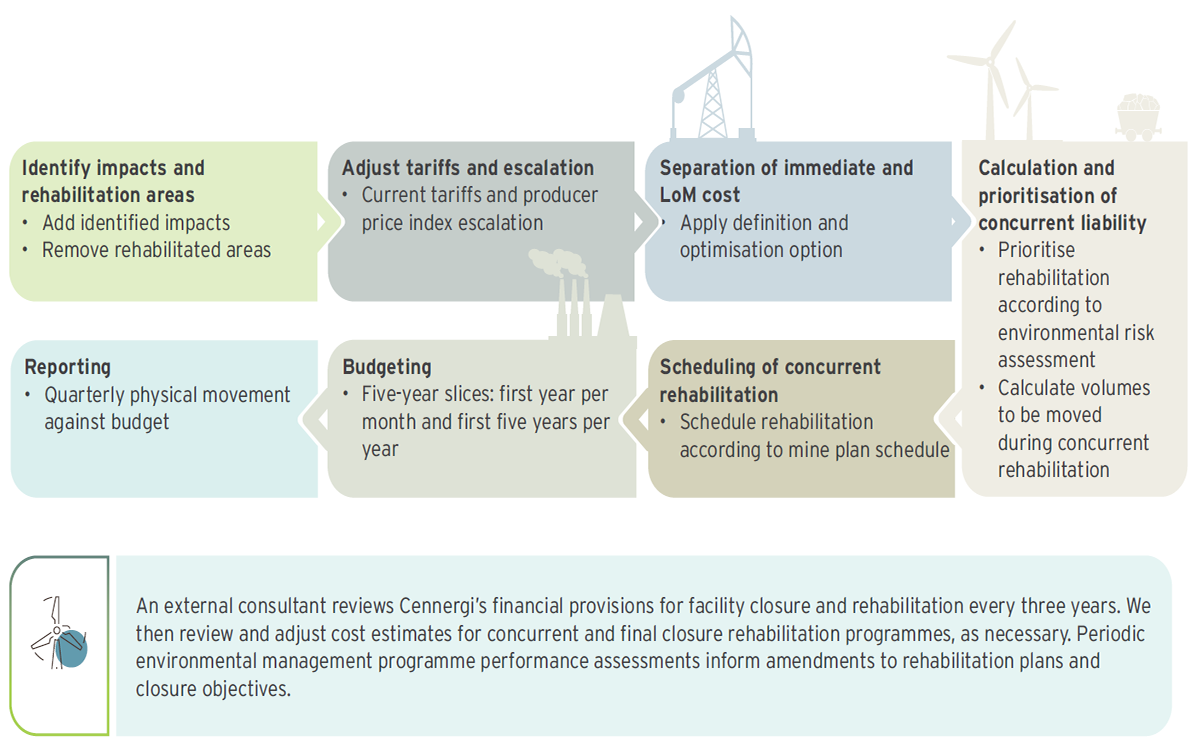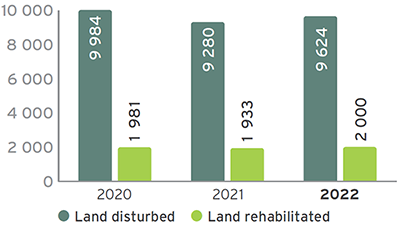Understanding that responsible mining practices continuously evolve, we have a holistic and integrated approach to mine closure, taking into account environmental protection, social wellbeing and financial performance.
Environmental rehabilitation is an opportunity to uplift our employees and communities with sustainable alternative land use.1
We manage our environmental liabilities and rehabilitation in compliance with legislation and evolving responsible mining practices. Our licence to operate depends on a holistic and integrated approach to land management, mine closure and concurrent rehabilitation. Our approach therefore considers impacts on employees, communities, the environment, government and infrastructure. Further, our proactive management of environmental impacts minimises residual liabilities (ie water quality and quantity, and topsoil health) that could affect Exxaro's financial performance by completing concurrent rehabilitation timeously and to prevent water ingress into rehabilitated areas.
Independent technical and financial specialists, and our internal sustainability and finance departments, with expertise and experience in environmental management, calculate financial provisions in terms of GNR 1147 (financial provision for prospecting, exploration and mining operations).
We await promulgation of draft financial provision regulations for mine closure and rehabilitation (GN 765) issued on 27 August 2021. In the meantime, discussions continue between the environmental policy committee of the Minerals Council, on behalf of Exxaro and our mining peers, and the DMRE. The proposed regulations will repeal GNR 1147. All our BUs will be continuously assessed according to GNR 1147. In the meantime, we conduct annual external assessments as necessary (at Matla, Belfast, Grootegeluk, Hlobane and Durnacol in 2022).
| Minerals Council's position on financial provisioning (www.mineralscouncil.org.za) |
Annual environmental liabilities update
Liabilities are approved through internal governance processes and updated accordingly.

Our sustainability managers, supported by the rehabilitation team and on-site environmental specialists led by the executive head: sustainability, oversee the implementation of our policy and practices.
| 1 | Mine rehabilitation is the restoration of the post-mined landscape to the intended post-mining land use. |
We strive to integrate land and rehabilitation liability management in daily mine planning to minimise final closure costs for each operation and optimise final land use after closure.

Information management |
Social |
We are working towards transferring 90% of post-mining land to emerging farmers in local communities by 2026.
To effectively and efficiently manage Exxaroowned land to support current and future operations, assist with biodiversity offsets and create social impact, we categorise our land parcels as follows:
Long-term agricultural leases Our minerals succession programme supports farmers by enabling access to resources (funding, mechanisation, inputs and training) in a three-year contract with an external service provider.
Available land for emerging farmers and communities
Donations
Biodiversity and conservation (such as Manketti Game Reserve)
Human resources |
Infrastructure |
Infrastructure (such as power lines, water pipes, buildings and dams) that can be used to implement and support a sustainable final land use is retained and incorporated into the final closure environmental management plan. Such infrastructure is then normally donated to a relevant entity managing the implementation of such plans.
Assets |
Any redundant but serviceable assets (such as vehicles and furniture) that can be utilised to support any social impact programmes are retained and transferred to a relevant entity managing the implementation of such plans.
Operations in active closure in 2022: Tshikondeni, Durnacol, Hlobane and Strathrae (2021: four)
Financial |
We annually review mine closure and rehabilitation financial provisions and rehabilitation plans and closure objectives are amended after environmental management programme performance assessments. Cost estimates of activities in the concurrent and final closure rehabilitation programme are reviewed and adjusted. External auditors visit our sites, review documents and audit the provisions twice a year.
Exxaro's Environmental Rehabilitation Fund (EERF) and additional bank guarantees provide for new developments and cover shortfalls in financial provisions. The EERF's assets are managed in terms of asset and liability modelling aligned with risk, return and liability on each site. The objective is to maximise investment growth in the cost of liability provisions. An external specialist supports EERF trustees with technical skills required to profile and identify suitable structures for assessment by the trustees. Current implementation includes:
Total unscheduled closure costs in 2022: R8 427 million (2021: R7 581 million)
Growth of Exxaro and Matla rehabilitation trust funds (combined): R19 million (2021: R217 million)
Mainly cash contributions, interest earned on investments and fair value adjustments.
Bank guarantees at year end: R3 606 million (2021: R3 606 million).
Update provisions twice a year highlights potential rehabilitation alternatives that could decrease the long-term closure liabilities of operations.
Health and hygiene |
Mining plan |
Each BU has five-year conceptual concurrent rehabilitation plans, schedules and associated budgets to:
Safety and risk control |
Health and safety at mines in closure is just as important as any operational mine. We apply the same health and safety standards and policies to all Exxaro's operations, including mines in closure. Security risks are a major challenge at any closed operation and infrastructure and assets need constant safeguarding during a closure process.
Interested and affected parties |
Environmental |
The disturbed footprint includes buildings, roads and mining areas to be rehabilitated in terms of the environmental management programme and the final land use plan (when maintenance and monitoring are needed).
Land disturbed versus land rehabilitated
(ha)

| Refer to the databook for more detail on land disturbed versus land rehabilitated. |
We will align our mine closure and rehabilitation approach with the Sustainable Growth and Impact strategy in 2023.
Our strategic objectives include:
Case study: Novel approach to rehabilitation at Grootegeluk (sustainability, case studies tab)
To mitigate the impacts of expanding the Grootegeluk complex, Exxaro is recreating non-perennial pans within the landscape.

Phumlani agri-village in Belfast
 Report Index
Report Index